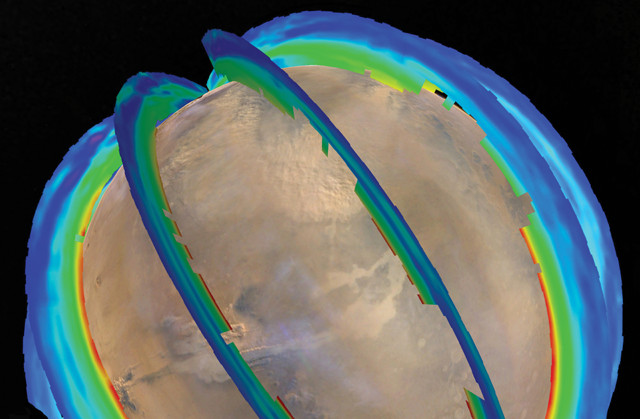
by Timothy Oleson Tuesday, August 16, 2016

Slices of temperature data recorded by the Mars Climate Sounder instrument aboard the Mars Reconnaissance Orbiter show a snapshot of the Martian atmosphere during southern hemisphere spring. Scientists used data like this to identify a pattern of recurring regional dust storms on the planet. Credit: NASA/JPL-Caltech.
With two rovers patrolling the surface of Mars, five spacecraft orbiting above it, and scientists here on Earth studying the Red Planet from afar, new findings are announced often. Here are a few of the latest updates.
Dust storms are common on wind-swept Mars: Localized storms occur frequently, usually lasting a few days, while massive storms sometimes shroud the southern hemisphere or even, in rare cases, the entire planet. In a new study, researchers have identified a recurring pattern of three distinct mid-size, or regional, dust storms — labeled A-, B- and C-type storms — that routinely last up to three weeks and can affect as much as a third of the planet in that time. The scientists analyzed atmospheric temperature readings collected by Mars Reconnaissance Orbiter from six recent Martian years in which a global storm did not occur; dust particles absorb sunlight, and large quantities of dust lofted into the skies cause atmospheric temperatures to spike. The team, led by David Kass of NASA’s Jet Propulsion Laboratory in Pasadena, Calif., reported in Geophysical Research Letters that in each of the six years studied, an A-type storm occurred in the southern hemisphere in the spring, followed by a B-type storm just before the summer solstice and a C-type storm sometime later in the southern summer. A- and C-type storms originate as collections of smaller storms over the northern hemisphere before crossing the equator and strengthening into regional storms, whereas B-type storms originate near the planet’s south pole. Dust storms overall are more prevalent during the southern hemisphere spring and summer because the planet is closer to the sun, and solar heating drives wind that kicks up dust from the surface.
Modeling based on studies of mid-latitude water-ice deposits as well as knowledge of how Mars’ orbit and axial tilt change over time previously suggested that the planet’s last ice age ended about 370,000 years ago. In a new study in Science, researchers report the clearest physical evidence yet of the transition out of that ice age, detected by satellite under the surface of the Martian polar-ice deposits. Isaac Smith of the Southwest Research Institute in Boulder, Colo., and colleagues studied hundreds of two-dimensional radar-sounding profiles from the north and south polar ice caps on Mars, which gave them cross-sectional views of distinct layers and features in the thick deposits. Below the top 100 to 320 meters of ice — a volume that appears to have been deposited with little interruption — they found signs, such as spiral-shaped troughs and receding slopes, that the ice cap had been eroding prior to that time. Unlike on Earth, where the ice caps expand during glacial periods and retreat during interglacials, ice ages on Mars are characterized by warm temperatures near the poles and the redistribution of ice from the polar caps to lower latitudes. The erosion surface and subsequent accumulation of ice — mostly deposited in the north polar ice cap — in the past 370,000 years thus represent the transition out of the last ice age, Smith’s team wrote.
In mid-June, the European Space Agency (ESA) announced that the Trace Gas Orbiter — the first half of the two-part joint ESA-Roscosmos ExoMars mission, which launched in March and is due to enter Mars’ orbit on Oct.19 — had snapped its first photos of the Red Planet and that the spacecraft, coupled to the Schiaparelli lander for the journey, had traveled half the roughly 500,000 kilometers to its destination. Earlier, however, in May, the mission team announced its decision to postpone the launch of the second half of ExoMars — comprising a rover and surface platform — from 2018 to 2020, citing delays in the development of the spacecraft and delivery of the scientific payload.
© 2008-2021. All rights reserved. Any copying, redistribution or retransmission of any of the contents of this service without the expressed written permission of the American Geosciences Institute is expressly prohibited. Click here for all copyright requests.